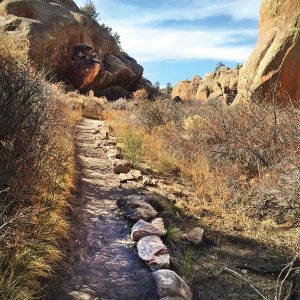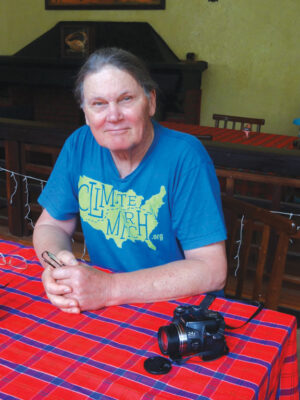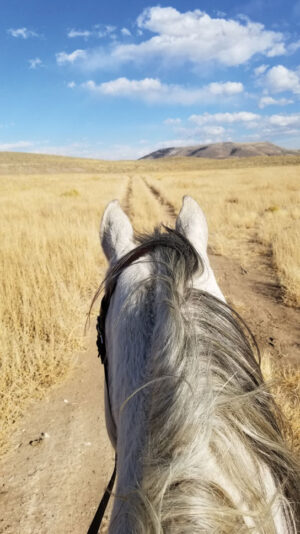By Hal Walter
There was a paper American flag taped to the stair handrail. Each weekday morning, through an intricate intercom system consisting of a cell phone, landline, iPod Touch and a Beats Pill speaker, the Pledge of Allegiance was recited, followed by the lunch menu, school announcements and an inspirational quote. Routines are important for a student on the autism spectrum. Even when school is at home.
We were well into the Covid-19 lockdown, April 2020. The isolation and the grind had become oppressive, with the great outdoors providing the only refuge. What’s more, the wind was howling.
When the day’s schoolwork was complete, I told Harrison to put on his running gear and get in the car. We stopped to dump the trash on the way out. Both totes were blown over. When I got out of the car my hat and sunglasses blew off my head and I watched them tumble down the road. It was a wrestling match with the Zephyr getting totes upright, the trash into them and the lids locked down. All the while my legs were being sandblasted. I chased down my hat and collected my sunglasses, and we drove off.
I didn’t know where to go. I really just wanted to get away—away from everything, and especially from the menacing wind. I headed east on the highway then south to a place that had been on my mind. The South Hardscrabble road was closed after the Junkins Park fire, which burned more than 18,000 acres in the fall of 2016. I’d heard it was now a trail.

I used to run this road a lot when I lived in Wetmore back in the mid-1980s, especially when I was training for the Boston Marathon in 1984. Every Friday morning, still brain-fogged from a night of editing copy at The Pueblo Chieftain, I ran the 20-mile round trip from my house to the “Florence Picnic Ground” with my dog Frisco. At the picnic grounds there were forest service outhouses, picnic tables and also a hand-pumped well. I would stop and get a drink by pumping, waiting for the gush of cold, clear water, then quickly cupping my hands beneath the spout. Then I ran the ten miles downhill back to my house. In the subsequent Reagan years the picnic ground was removed due to budget cuts. The outhouses disappeared. The pump to the well vanished.
Frisco was the greatest dog spirit I ever knew. When he died in 1990 I was devastated. Mary and I had just moved back from Leadville after my stint editing the Herald Democrat. A few months later Frisco developed canine leukemia and went down fast. I decided to bury him up there along the South Hardscrabble where he loved to run with me. I remember carrying his cancer-ravaged carcass down a steep embankment, then crossing the creek. He had been a fairly large border collie but now he weighed virtually nothing. I ambled through the aspens with Frisco in my arms and finally decided upon a spot. I dug a grave at the foot of a small aspen sapling and covered him. Then I carved an “F” in the bark of that tree and walked away. For years thereafter, whenever I ran on that road, I would often imagine his spirit running with me. I never had any intention of returning to the gravesite.
Since that fire I had thought a lot about Frisco and wondered what had become of the place I’d buried him. The Forest Service closed off the road to all travel for many years after the fire, and I’d heard that flash floods after the fire had wiped out much of that canyon.
There’s a makeshift trailhead at the west end of the road. We headed out hiking and jogging. I told Harrison about the significance of this place as we went along. Much of the road is just as it was before the fire, smooth and untraveled. But in several places it has been completely wiped out by flash-flooding, erosion and massive deposits of rock and other debris. Sometimes the creek runs right down the road, or meanders across it. The mosaic-pattern wildland fire left a great deal of the surrounding landscape unburned while some mountainsides were completely devastated.
We jogged and hiked and scrambled over the rougher sections. I noted the fresh hope of spring on the budding aspens and willows. Eventually we came to the general area where I’d buried Frisco. To my amazement it had been scorched but not completely incinerated. We crossed the creek, scrambling down what was left of the embankment I’d carried my dead dog down all those years ago. The flooding had deposited tons and tons of sand and gravel and larger rocks, and some blackened logs. We wandered around in this forested glade. Everything seemed different because the trees of course had grown much larger, plus the fire had vaporized a lot of the underbrush. Some of the aspens had literally been peeled by the heat of the blaze yet not fully burned.
At last I found the tree that I believe to be where I buried Frisco. There was a mark that looked like the “F” which had grown out and healed over before the aspen was killed by the fire. A lot of sand and rock from the flood covered where the dog would have been buried. I looked around but could not find another spot that looked more familiar than this. This had to be it. I yelled out to Frisco and his name echoed back. Harrison seemed puzzled. For the first time I noticed there was no wind.
We bushwhacked a different route back to the road, crossing the creek again before continuing on downhill, at last arriving at the old picnic ground site. I could hardly recognize it but found the flat place where the outhouses had been. I had decided the well head must have been covered by flood debris, but after some looking around found the metal cover where the hand pump had been bolted down just uphill from the wash.
I really wanted to continue onward but we’d already gone much farther than I‘d originally intended. So we turned back with the low evening sunlight splashing our faces. After 40 minutes of steady uphill running we were nearing the trailhead. Harrison said his legs were tired and I’d had enough, too. So we hiked the last stretch.
Just before the trailhead I walked over to the creek to see if any fish had survived the fire and flooding. As I approached the stream its surface appeared quiet and inky in the dimming light. I surprised a beaver and it dove for cover with a loud splash. I looked all around and took everything in, then glanced at my watch. It said we’d gone 8.2 miles but it seemed we’d traveled to an alternate reality.
Hal Walter is the distance-running and academic support coach at Custer County High School. He writes from his home in the Wet Mountains.



